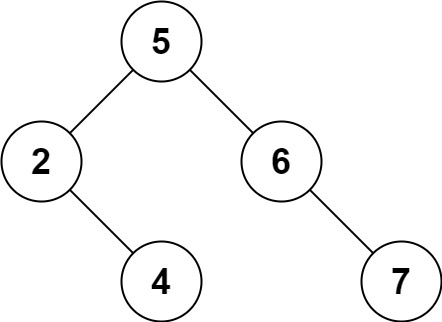//给定一个二叉搜索树的根节点 root 和一个值 key,删除二叉搜索树中的 key 对应的节点,并保证二叉搜索树的性质不变。返回二叉搜索树(有可能被更新)的根节点的引用。
//
//一般来说,删除节点可分为两个步骤:
//
//
// - 首先找到需要删除的节点;
// - 如果找到了,删除它。
//
//
//
//
//示例 1:
//
//
//
//
//输入:root = [5,3,6,2,4,null,7], key = 3
//输出:[5,4,6,2,null,null,7]
//解释:给定需要删除的节点值是 3,所以我们首先找到 3 这个节点,然后删除它。
//一个正确的答案是 [5,4,6,2,null,null,7], 如下图所示。
//另一个正确答案是 [5,2,6,null,4,null,7]。
//
// //
//
//
//示例 2:
//
//
//输入: root = [5,3,6,2,4,null,7], key = 0
//输出: [5,3,6,2,4,null,7]
//解释: 二叉树不包含值为 0 的节点
//
//
//示例 3:
//
//
//输入: root = [], key = 0
//输出: []
//
//
//
//提示:
//
//
// - 节点数的范围
[0, 104].
// -105 <= Node.val <= 105- 节点值唯一
// root 是合法的二叉搜索树-105 <= key <= 105
//
//
//
//进阶: 要求算法时间复杂度为 O(h),h 为树的高度。
//
👍 782👎 0
package leetcode.editor.cn;
import com.code.leet.entiy.TreeNode;
// 450:删除二叉搜索树中的节点
public class DeleteNodeInABst {
public static void main(String[] args) {
Solution solution = new DeleteNodeInABst().new Solution();
// TO TEST
}
//leetcode submit region begin(Prohibit modification and deletion)
/**
* Definition for a binary tree node.
* public class TreeNode {
* int val;
* TreeNode left;
* TreeNode right;
* TreeNode() {}
* TreeNode(int val) { this.val = val; }
* TreeNode(int val, TreeNode left, TreeNode right) {
* this.val = val;
* this.left = left;
* this.right = right;
* }
* }
*/
class Solution {
public TreeNode deleteNode(TreeNode root, int key) {
if (root == null) {
return root;
}
TreeNode node = root;
TreeNode left;
if (root.val == key) {
if (root.right != null) {
node = root.right;
left = root.left;
root = node;
while (node.left != null) {
node = node.left;
}
node.left = left;
} else {
root = root.left;
}
} else if (root.val > key) {
if (root.left != null) {
root.left = deleteNode(root.left, key);
}
} else {
if (root.right != null) {
root.right = deleteNode(root.right, key);
}
}
return root;
}
}
//leetcode submit region end(Prohibit modification and deletion)
}


//